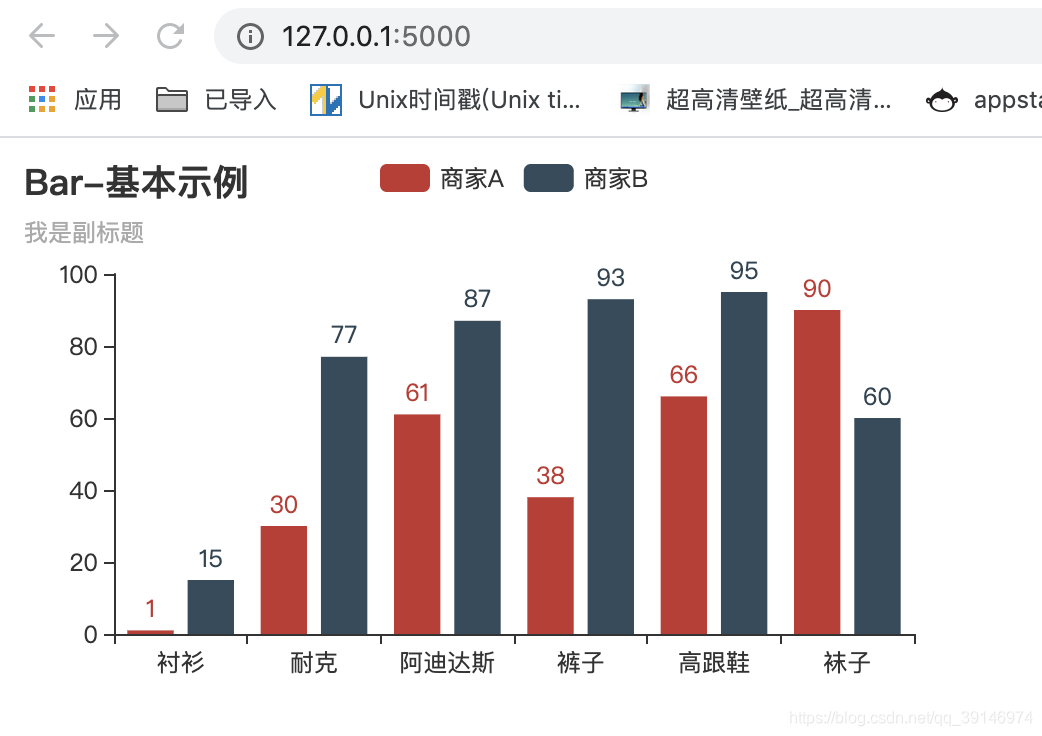我们用falsk来做个小demo
创建app.py 和 templates/index.html and templates/line_on.html
我们先写下前端的
index.html
<!DOCTYPE html>
<html>
<head>
<meta charset="UTF-8">
<title>Awesome-pyecharts</title>
<script src="https://cdn.bootcss.com/jquery/3.0.0/jquery.min.js"></script>
<script type="text/javascript" src="https://assets.pyecharts.org/assets/echarts.min.js"></script>
</head>
<body>
<div id="bar" style="width:500px; height:300px;"></div>
<script>
var chart = echarts.init(document.getElementById('bar'), 'white', {renderer: 'canvas'});
$(
function () {
fetchData(chart);
setInterval(fetchData, 2000);
}
);
function fetchData() {
$.ajax({
type: "GET",
url: "http://127.0.0.1:5000/barChart",
dataType: 'json',
success: function (result) {
chart.setOption(result);
}
});
}
</script>
</body>
</html>
定时刷新的核心在于 HTML 的 setInterval 方法。
line_on.html
<!DOCTYPE html>
<html>
<head>
<meta charset="UTF-8">
<title>Awesome-pyecharts</title>
<script src="https://cdn.bootcss.com/jquery/3.0.0/jquery.min.js"></script>
<script type="text/javascript" src="https://assets.pyecharts.org/assets/echarts.min.js"></script>
</head>
<body>
<div id="bar" style="width:1000px; height:600px;"></div>
<script>
var chart = echarts.init(document.getElementById('bar'), 'white', {renderer: 'canvas'});
var old_data = [];
$(
function () {
fetchData(chart);
setInterval(getDynamicData, 2000);
}
);
function fetchData() {
$.ajax({
type: "GET",
url: "http://127.0.0.1:5000/lineChart",
dataType: "json",
success: function (result) {
chart.setOption(result);
old_data = chart.getOption().series[0].data;
}
});
}
function getDynamicData() {
$.ajax({
type: "GET",
url: "http://127.0.0.1:5000/lineDynamicData",
dataType: "json",
success: function (result) {
old_data.push([result.name, result.value]);
chart.setOption({
series: [{data: old_data}]
});
}
});
}
</script>
</body>
</html>
然后是我们的python代码
app.py
# -*- coding: utf-8 -*-
# @Time : 2020-01-14 10:11
# @Author : lizhiming flask可视化模板
# @Email : 616356241@qq.com
# @File : app.py
from random import randrange
from flask import Flask, render_template
from flask.json import jsonify
from pyecharts import options as opts
from pyecharts.charts import Bar
from pyecharts.charts import Line
app = Flask(__name__, static_folder="templates")
def bar_base() -> Bar:
c = (
Bar()
.add_xaxis(["衬衫", "耐克", "阿迪达斯", "裤子", "高跟鞋", "袜子"])
.add_yaxis("商家A", [randrange(0, 100) for _ in range(6)])
.add_yaxis("商家B", [randrange(0, 100) for _ in range(6)])
.set_global_opts(title_opts=opts.TitleOpts(title="Bar-基本示例", subtitle="我是副标题"))
)
return c
def line_base() -> Line:
line = (
Line()
.add_xaxis(["{}".format(i) for i in range(10)])
.add_yaxis(
series_name="",
y_axis=[randrange(50, 80) for _ in range(10)],
is_smooth=True,
label_opts=opts.LabelOpts(is_show=False),
)
.set_global_opts(
title_opts=opts.TitleOpts(title="动态数据"),
xaxis_opts=opts.AxisOpts(type_="value"),
yaxis_opts=opts.AxisOpts(type_="value"),
)
)
return line
@app.route("/")
def index():
return render_template("index.html")
@app.route("/barChart")
def get_bar_chart():
c = bar_base()
return c.dump_options_with_quotes()
@app.route("/lineChart")
def get_line_chart():
c = line_base()
return c.dump_options_with_quotes()
idx = 9
@app.route("/lineDynamicData")
def update_line_data():
global idx
idx = idx + 1
return jsonify({"name": idx, "value": randrange(50, 80)})
@app.route("/index/line")
def line():
return render_template("line_on.html")
if __name__ == "__main__":
app.run()
ok测试一下

来源:CSDN
作者:INSNNP李志明
链接:https://blog.csdn.net/qq_39146974/article/details/103969729